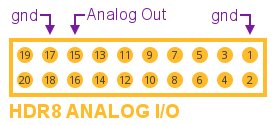Difference between revisions of "Example mcp4922 test"
(→Using mcp4922_test) |
|||
| Line 33: | Line 33: | ||
===Using <code>mcp4922_test</code>=== | ===Using <code>mcp4922_test</code>=== | ||
| + | |||
| + | Run it from the console... | ||
./mcp4922_test | ./mcp4922_test | ||
| − | + | Regard the HDR ANALOG I/O HEADER on your foo foo board. | |
| + | |||
| + | <pic of header> | ||
| + | |||
| + | Pin 15 is analog out 0 and pin 16 is analog out 1. Pins 1, 2, 17 and 18 are all ground. | ||
| + | |||
| + | [[File:hdr8_analog_io_header_detail.jpg]] | ||
| + | |||
| + | When we execute <code>mcp4922_test</code> we get a 5v sine signal on pin 15 and a cosine on pin 16. We can watch the signals on an oscilloscope or listen to them on a speaker. | ||
Revision as of 11:23, 31 December 2013
This is a guide to the mcp4922_test C example project included in the EMAC OE SDK.
This is an example application for accessing the EMAC interface for the on-board DtoA of the SoM-150ES. This interface uses the EMAC ioex class to provide a GPIO-like interface (see also the egpc project). This application outputs a sine wave on channel 0 and a cosine wave on channel 1.
The mcp4922_test project builds one executable: mcp4922_test.
Contents
Opening, Building and Uploading the Project Files
1. Open the C/C++ editing perspective.
stub
2. Open the project files.
stub
3. Build the project.
stub
4. Upload the executables to the target system.
stub
Usage and Behavior
mcp4922_test outputs a sine wave on channel 0 and a cosine wave on channel 1.
Hardware Requirements
The mcp4922_test C example project requires an EMAC SoM-150ES carrier board.
Using mcp4922_test
Run it from the console...
./mcp4922_test
Regard the HDR ANALOG I/O HEADER on your foo foo board.
<pic of header>
Pin 15 is analog out 0 and pin 16 is analog out 1. Pins 1, 2, 17 and 18 are all ground.
When we execute mcp4922_test we get a 5v sine signal on pin 15 and a cosine on pin 16. We can watch the signals on an oscilloscope or listen to them on a speaker.
